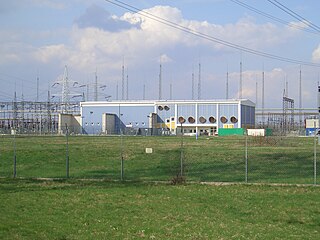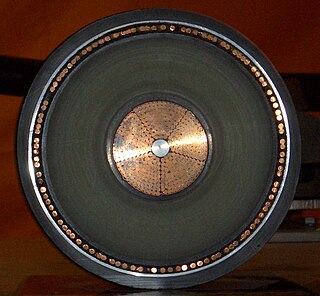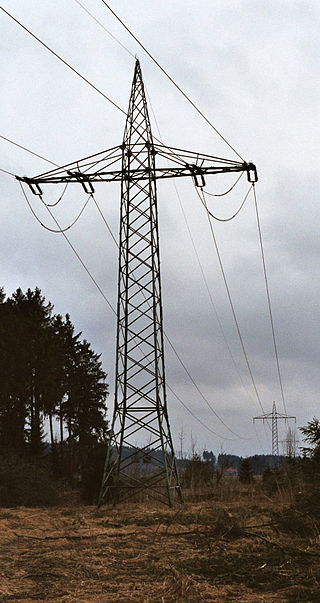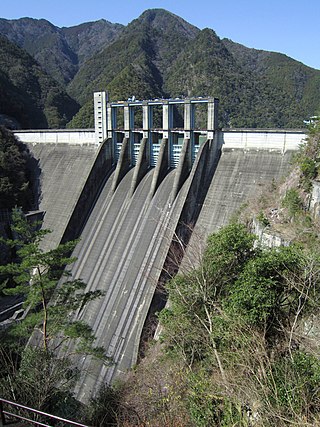
A high-voltage direct current (HVDC) electric power transmission system uses direct current (DC) for electric power transmission, in contrast with the more common alternating current (AC) transmission systems. Most HVDC links use voltages between 100 kV and 800 kV.

A substation is a part of an electrical generation, transmission, and distribution system. Substations transform voltage from high to low, or the reverse, or perform any of several other important functions. Between the generating station and consumer, electric power may flow through several substations at different voltage levels. A substation may include transformers to change voltage levels between high transmission voltages and lower distribution voltages, or at the interconnection of two different transmission voltages. They are a common component of the infrastructure. There are 55,000 substations in the United States.

A transmission tower is a tall structure, usually a lattice tower made of steel that is used to support an overhead power line. In electrical grids, transmission towers carry high-voltage transmission lines that transport bulk electric power from generating stations to electrical substations, from which electricity is delivered to end consumers; moreover, utility poles are used to support lower-voltage sub-transmission and distribution lines that transport electricity from substations to electricity customers.

The Kontek HVDC is a 170-kilometre (110 mi) long, monopolar 400 kV high-voltage direct current cable between Germany and the Danish island Zealand. Its name comes from "continent" and the name of the former Danish power transmission company "Elkraft", which operated the power grid on the Danish islands Lolland, Falster and Zealand and had the abbreviation "ek". As of today, the cable is operated by Energinet.dk in Denmark and 50Hertz Transmission GmbH in Germany.

The Baltic Cable is a monopolar HVDC power line running beneath the Baltic Sea that interconnects the electric power grids of Germany and Sweden. Its maximum transmission power is 600 megawatts (MW).

The GK Vienna–Southeast was a back-to-back HVDC station linking the electric power grids of Austria and Hungary. It operated between June 1993 and October 1996.

Bentwisch is a municipality in the Rostock district, in Mecklenburg-Vorpommern, Germany, to the east of Rostock. Since its merger with Klein Kussewitz in January 2018, the municipality has 3,174 inhabitants and covers 29.19 square kilometres. Due to its proximity to Rostock, the B 105, and the A 19, Bentwisch became a place of industry after German reunification.

The Berlin 380 kV electric line is a 38.3-km double-circuit high-voltage electric three-phase power line in Berlin. An unusual system for a municipality, it was installed by the West Berlin Bewag utility company during the division of the city. Since 1951, West Berlin had been cut off from the East Berlin and East German power networks, and maintained an independent power generation capacity that was not connected to any other power grid. Berlin was connected to the western European power grid in 1994, following German reunification, by extending the 380 kV line.
Square Butte is the designation of a high-voltage direct current transmission line in the United States between the Milton R. Young Power Plant near Center, North Dakota at 47°4′18″N101°11′45″W and the Arrowhead converter station near Adolph at 46°46′25″N92°17′39″W. It was built by Minnkota Power Cooperative and Minnesota Power and went in service in 1977. In 2009, an agreement was executed between the two companies whereby Minnkota gets the rights to all the power currently transmitted over the line while Minnesota Power takes full ownership of the line to transmit power from new sources in the Center area.

A traction network or traction power network is an electricity grid for the supply of electrified rail networks. The installation of a separate traction network generally is done only if the railway in question uses alternating current (AC) with a frequency lower than that of the national grid, such as in Germany, Austria and Switzerland.

A cable landing point is the location where a submarine or other underwater cable makes landfall. The term is most often used for the landfall points of submarine telecommunications cables and submarine power cables. The landing will either be direct or via a branch from a main cable using a submarine branching unit. The branch can be several kilometres long.

GKK Etzenricht, an abbreviation of Gleichstromkurzkupplung Etzenricht, meaning Etzenricht HVDC-back-to-back station, was an HVDC back-to-back facility near Etzenricht in the district of Neustadt an der Waldnaab in Bavaria, Germany. It was built on the site of the Etzenricht substation, a 380 kV/220 kV/110 kV-substation, which went into service in 1970 and expanded afterwards several times. The facility was used between 1993 and 1995 for the exchange of power between Germany and the Czech Republic, operated by Bayernwerk AG.

The GK Dürnrohr was a high-voltage direct current back-to-back scheme west of Dürnrohr substation, which was used for the energy exchange between Austria and Czechoslovakia between 1983 and 1996. The installation is no longer in use.

The Sakuma Dam is a dam on the Tenryū River, located on the border of Toyone, Kitashitara District, Aichi Prefecture on the island of Honshū, Japan. It is one of the tallest dams in Japan and supports a 350 MW hydroelectric power station. Nearby a frequency converter station is installed, allowing interchange of power between Japan's 50 Hz and 60 Hz AC networks.

HVDC BorWin1 is the first HVDC facility in the world to be built for importing power from an offshore wind park to shore, and the first to use voltage source converters (VSC) in Germany. It connects the offshore wind park BARD Offshore 1 and other offshore wind farms in Germany near Borkum to the European power grid. The facility was built by ABB and has a capacity of 400 MW at a bipolar voltage of ±150 kV. HVDC BorWin1, which leads from BorWin Alpha Offshore Platform to Diele substation, consists of a 75 kilometres (47 mi) of underground and 125 kilometres (78 mi) of submarine cable.
HVDC Ekibastuz–Centre is an unfinished HVDC transmission line between Ekibastuz in Kazakhstan and Tambov in Russia whose construction was started in 1978. It was planned to have a length of 2,414 kilometres (1,500 mi), which would have made it the longest powerline of the world with a maximum transmission rate of 6,000 MW and a transmission voltage of 750 kV between conductor and ground. For this line the erection of 4,000 pylons, most 41 metres (135 ft) tall, were required. Several hundred kilometres were built, including a Volga crossing on three 124 metres (407 ft) tall towers near Saratov, which were erected between 1989 and 1991. At Ekibastuz construction work at the terminal was started, while it was not the case at Centre substation, Tambov.
Zhoushan HVDC was the first HVDC scheme built in China and first put into service in July 2014.

Sagunto Power Station is a natural gas-fired combined-cycled power station in Sagunto near Valencia, Spain. It went into operation in 2007. The power station is owned and operated by Unión Fenosa.
Rivera HVDC Back-to-back station is the first HVDC Back-to-back station situated south of Rivera, Uruguay at 30°56′29″S55°33′34″W. It was built by Areva and inaugurated in 2000. Rivera HVDC Back-to-back station whose function is to perform a conversion of 50 Hz power from the power grid of Uruguay into 60 Hz for the power grid of Brazil, operates with a DC voltage of 20 kV. The transmission rate is 70 MW. Rivera HVDC Back-to-back station is connected with the power grid of Uruguay by a short single-circuit 150 kV line to Rivera substation situated at 30°56′39″S55°33′9″W. The connection to the power grid of Brazil is done by a single-circuit 230 kV AC line, which crosses the border between Uruguay and Brazil at 30°52′17″S55°33′30″W and ends at Livramento Substation 30°51′44″S55°32′34″W. As this interconnection does not fit today's requirement, a second interconnection over Melo HVDC Back-to-back station was built.


















